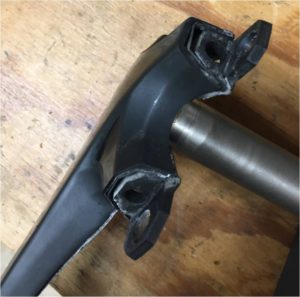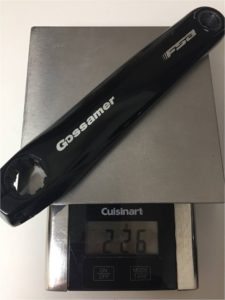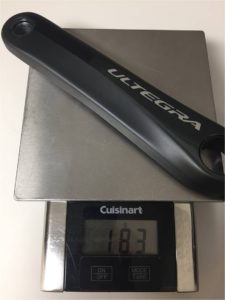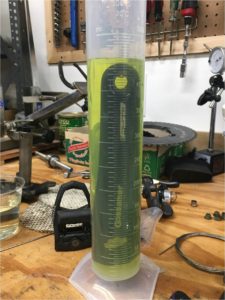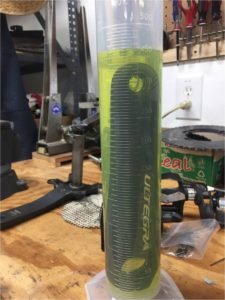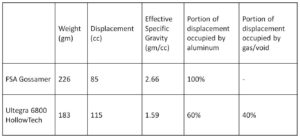I was wondering the other day about Shimano HollowTech cranks.
How do they make them hollow?
How hollow are they?
I learned the answer to my first question when my friend Kara brought over her bike and said “There’s something wrong with my cleats or maybe my pedals. They feel spongy.”
There was nothing wrong with her pedals or her cleats. Inspection of the crank revealed separation between the inner and outer surfaces of the right crankarm in the spider area. In simple terms, it came unglued. By the way, although Kara is a strong rider, she weighs maybe 120 lbs, so this is not a simple case of excessive torque. Larger riders apply much more power than Kara through identical cranks.
I thought this was a weird failure mode, so I Googled “Ultegra 6800 crank failure”. I found that while not common, it is not unheard of. Good move on Kara’s part, sensing that something was wrong before the separation led to a completely severed crankarm.
I’m not bashing Shimano here. Google “Broken Bicycle crankarm images” and you’d think these things – any brand – are falling apart left and right.
Today’s post is not a root cause analysis. I don’t know why Kara’s crank failed. Maybe the glue was out of spec. Maybe she crashed on it. Maybe some kind of solvent or some environmental factor destabilized the glue, maybe it was assembled on a humid day…
Anyway, now I know, Shimano makes their HollowTech cranks hollow by bonding two halves of a “clamshell” together with what for lack of a better word I will call glue. They also make their outer chainrings hollow. On the chainring you can see the bond line between the two elements. It is much more difficult to identify the seam on a crankarm. You can see a squirt of excess glue on the inside of the spider.
My first reaction was “Glue? Really?” But wait a minute. My entire carbon fiber bicycle is nothing but carbon fiber cloth and glue. Heck, NASA used glue to hold the space shuttle together…. Never mind. My point is that using an engineered glue is a valid assembly process.
Remember when I described using a heat gun to loosen a stuck pedal. I said that on a carbon fiber crank you need to be careful with heat. I would apply that warning to a HollowTech crank as well, because I don’t know what the temperature rating of the glue is. If you can’t hold it in your hand for a few seconds, it’s probably too hot.
Making crankarms hollow is a very effective way to reduce weight without sacrificing rigidity. Rather than go all technical, I’ll just point out that your whole bicycle is made of hollow tubes for exactly this reason. The trick is manufacturing a hollow crankarm. Shimano’s bonded clamshell solution is elegant, but obviously dependent on the integrity of the bonding agent (glue).
I also was wondering how much weight is saved by going hollow? Calculating specific gravity turns out to be an easy non-destructive way to determine how much aluminum is missing from the interior. I decided to evaluate a left crankarm only, mostly because a right crankarm with the spider wouldn’t fit in my graduated cylinder.
The specific gravity of aluminum is ~2.7 gm/cc. By measuring the weight and displacement of a solid crank I can determine the specific gravity of the alloy used.
By measuring the displacement of a HollowTech crankarm and its weight, I can calculate an effective specific gravity, which it turns out is significantly below solid aluminum. In the table below I compare a typical solid construction crankarm (FSA Gossamer) to a HollowTech crankarm.
A few comments on the above photos. That’s not Mountain Dew; it’s just water with a few drops of food coloring. Before you tell me my displacement numbers don’t add up – I started with different amounts of water in the graduated cylinder for the different cranks.
My FSA sample is 175mm; my HollowTech is 170mm, so my analysis unfairly favors the HollowTech design by a few grams. An eyeball estimate suggests that shortening the gossamer crank by 5mm would remove about 2 cc’s or 5.5 grams of material.
We can calculate that if a HollowTech crankarm was solid, it would weigh an uncompetitive 306 grams, assuming the same density alloy is used as the FSA.
Is the HollowTech crankarm stiffer? According to everything I learned from Dr. Carver at LSU 43 years ago, it has to be, if it is made out of similar material. By moving material out away from the central axis of a beam, you increase both the area and polar moments of inertia; the beam (crankarm) becomes more resistant to bending and torsion. Can you feel the difference? I don’t know. Is the difference even detectable? I don’t know, but I think I’ll do some calculations and run a test if I can devise a way to rigidly anchor the spindle end of the crankarm.
Until then, Tailwinds!
Killa
